
Pamplona, historically also known as Pampeluna in English, is the capital city of the Chartered Community of Navarre, in Basque Country.
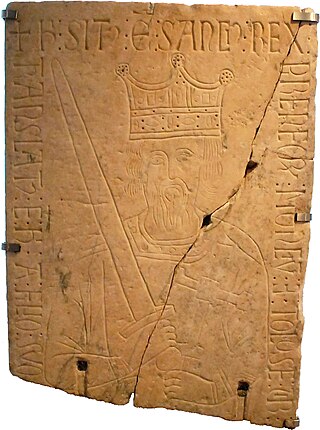
Sancho Garcés III, also known as Sancho the Great, was the King of Pamplona from 1004 until his death in 1035. He also ruled the County of Aragon and by marriage the counties of Castile, Álava and Monzón. He later added the counties of Sobrarbe (1015), Ribagorza (1018) and Cea (1030), and would intervene in the Kingdom of León, taking its eponymous capital city in 1034.

The Kingdom of Navarre, originally the Kingdom of Pamplona, was a Basque kingdom that occupied lands on both sides of the western Pyrenees, with its northernmost areas originally reaching the Atlantic Ocean, between present-day Spain and France.
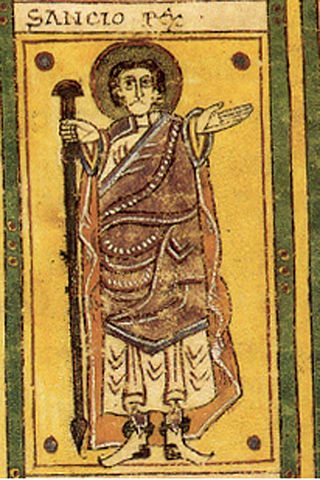
Sancho Garcés II, also known as Sancho II, was King of Pamplona and Count of Aragon from 970 until his death in 994. He was the eldest son of García Sánchez I of Pamplona and Andregoto Galíndez. He recognised the Kingdom of Viguera during his reign.
Íñigo Arista was a Vascon chieftain of the Eneko tribe, and the first king of Pamplona. He is thought to have risen to prominence after the defeat of local Frankish partisans at the Battle of Pancorbo in 816, and his rule is usually dated from shortly after the defeat of a Carolingian army in 824.

García Sánchez II, was King of Pamplona and Count of Aragon from 994 until his death c. 1000. He was the eldest son of Sancho II of Pamplona and Urraca Fernández and the second Pamplonese monarch to also hold the title of count of Aragon. Modern historians refer to him as the Tremulous, though this appellation likely originally applied to his grandfather, García Sánchez I of Pamplona.
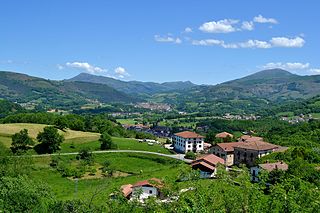
Baztan is a municipality from the Chartered Community of Navarre, northern Spain. It is located 58 km (36 mi) from Pamplona, the capital of Navarre. It is the largest municipality in Navarre, with around 376.8 km2 and just over 8,000 inhabitants.
Lumbier is a village and municipality in the province and autonomous community of Navarre, in the north of Spain, 38 km from the capital of the community, Pamplona. It has a population of about 1400. It stands on the River Salazar in a region of natural interest. It also has interesting historical connections.

Oteiza or Oteiza de la Solana, is a village and a Spanish municipality of the Foral Community of Navarra, located in the merindad of Estella, in the Estella Oriental region, 51 km from the capital of the community, Pamplona. Its population in 2016 was 939.

Hernani is a town and municipality located in the province of Gipuzkoa, Basque Autonomous Community, Spain. The town sits on the left bank of the Urumea river. It is located at a distance of 9.2 km from San Sebastián. The municipality of Hernani occupies an area of approximately 40 square kilometres and is bordered by San Sebastián, Astigarraga, Arano, Elduayen, Errenteria, Lasarte-Oria and Urnieta.

Saints Nunilo and Alodia were a pair of child martyrs from Huesca. Born of a mixed marriage, they eschewed the Islam of their father in favour of their mother's Christianity. They were executed by the Muslim authorities of Huesca in accordance with sharia law as apostates. Their feast day is 22 October.
The Battle of Torrevicente was fought on Saturday, 9 July 981 between a force loyal to the Caliphate of Córdoba under the command of Ibn Abi ‘Amir and a rebel force under Galib ibn Abd al-Rahman and his Christian allies, King Ramiro Garcés of Viguera and Count García Fernández of Castile. It was Galib's intention to continue the policy of previous caliphs, Abd ar-Rahman III and al-Hakam II, which was to maintain supremacy over the Christian principalities in peace. Ibn Abi ‘Amir was pursuing a new policy of jihad, signalled by his seven aggressive actions against the Christians in the previous three years. Both Ramiro and Galib died during the battle and Ibn Abi ‘Amir was victorious. It was the twelfth of Ibn Abi ‘Amir's military campaigns, and was called in Muslim sources the "Campaign of the Victory".
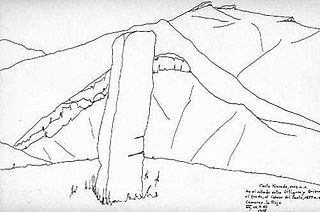
Fortún Ochoiz or Fortún Ochoa was a Navarrese nobleman, diplomat, and statesman. Throughout his known career he held the tenencia of La Rioja, an important marcher lordship, the rump of the Kingdom of Viguera, and the foundation for the Lordship of Los Cameros. Fortún helped fix the border between southwestern Navarre and the Kingdom of Castile, and he married into the royal family and fought alongside his father-in-law, García Sánchez III in the Reconquista. His ancestors may have belonged to the Banu Qasi, themselves descended from Visigothic nobility, and his descendants continued to rule their patrimony until the twelfth century.
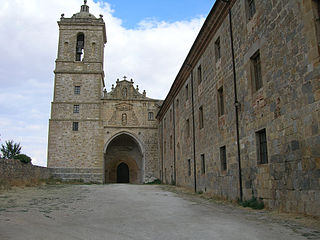
Santa María la Real de Irache is a former Benedictine monastery located in the town of Ayegui, Navarre, Spain. It dates from the eighth century, although the surviving buildings are later.

Fortún Garcés Cajal was a Navarro-Aragonese nobleman and statesman, perhaps "the greatest noble of Alfonso the Battler's reign". He was very wealthy in both land and money, and could raise two to three hundred knights for his retinue, funded both out of his treasury and enfeoffed on his lands.
Monasteries in Spain have a rich artistic and cultural tradition, and serve as testament to Spain's religious history and political-military history, from the Visigothic Period to the Middle Ages. The monasteries played an important role in the recruitment conducted by Christian aristocracy during and after the progress of the Reconquista, with the consequent decline in the Muslim south of the peninsula.
Leire is a Basque feminine given name that is derived from the name of the Monastery of San Salvador of Leyre in Navarre, Spain. It was among the top 10 most popular names given to newborn girls in Basque Country in Spain in 2011. Leire is therefore quite a well known name in Spain and Basque Country.

The Leyre Casket is one of the jewels of Hispano-Arab Islamic art. It is a casket or reliquary made of elephant ivory which was made in 1004/5 in the Caliphate of Cordoba.

The Sierra de Leyre or Sierra de Leire is a mountain range in Navarre (Spain). It is the first pre-Pyrenean mountain range and is located in the northeast of the Comunidad Foral. It is 30 km long and has an east–west orientation.



















